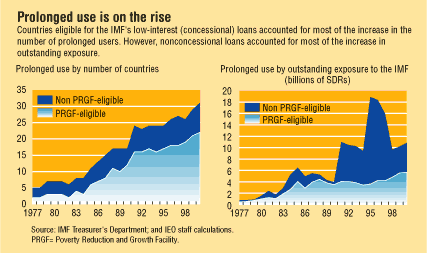 About F&D Subscribe Back Issues Write Us Copyright Information Free Email Notification Receive emails when we post new
items of interest to you. |
Prolonged Use of IMF Loans David Goldsbrough, Kevin Barnes, Isabelle Mateos y Lago, and Tsidi Tsikata How much of a problem is it? The IMF's original mandate was to provide assistance to member countries in short-term crisis situations, but, in practice, a number of countries have depended on IMF support for long periods. The Philippines, for instance, was engaged in IMF-supported programs for almost 25 years over 1971-2000, and several other countries (for example, Haiti, Panama, Pakistan, and Senegal) for 20 years or more. Such cases of prolonged involvement with IMF-supported programs raise many questions at the heart of recent controversies about the IMF's role in countries requiring a longer adjustment period. Some critics have argued that prolonged use constitutes a departure from the IMF's traditional mandate of providing temporary balance of payments support and suggests that IMF-supported programs are not effective. Others have argued that frequent recourse to IMF lending arrangements can take place for good reasons in countries with deep-seated adjustment problems and that it can be fully compatible with the IMF's mandate. This is why the IMF's Independent Evaluation Office, established in 2001, chose, as its first study, to investigate the issue of prolonged use. The report looks at the questions of what factors account for prolonged use, when it is a problem, and what can be done to ameliorate the situation. Who are the prolonged users?The cases mentioned above are symptomatic of the substantial rise in the past two decades of the number of prolonged users of IMF loans—defined as countries engaged in IMF-supported programs for at least 7 years out of any 10. Indeed, over 30 countries now fall into this category. During 1971-2000, 51 countries out of 128 borrowers were prolonged users at some point (Table 1). Most of the increase in prolonged use has involved low-income countries eligible for the IMF's concessional (or low interest) loans or "facilities," but, in financial terms, the bulk of commitments to prolonged users concerns the IMF's nonconcessional resources, and their expansion has been even larger (see chart). Prolonged use is also persistent in the sense that relatively few countries "graduate" from such use.

Our study found that prolonged users typically faced wider imbalances and more deep-seated problems than other countries receiving IMF financing. However, these characteristics need not necessarily lead to prolonged use, especially if they are well integrated into the design of adjustment programs. One therefore needs to look for additional explanations. We were able to identify three major systemic factors, combined with flaws in program design and weaknesses in governance. The first systemic factor is a broadening of the rationale for IMF program involvement. Over time, it was accepted that many balance of payments problems, especially in the low-income countries, arose from deep-seated structural problems that required more time for adjustment. This led to an acceptance of IMF financing being provided over a longer period in low-income countries and to the establishment of the concessional facilities in the mid-1980s, with limits on the time spent under this type of arrangement gradually relaxed and eventually eliminated. However, the evolution of these facilities did not explicitly recognize some of the potential consequences for the extent of prolonged use. As a result, the IMF was left with a mismatch between its core operational approach (which is still focused on promising and achieving a restoration of external viability within a relatively short time frame) and some of the new tasks it is being asked to perform. This mismatch of time frames is an important factor behind the tendency highlighted by the report toward overoptimism in program design. The second factor is the increased emphasis on IMF lending arrangements as a "seal of approval" for other sources of financing (for example, debt relief and adjustment loans or grants from many multilateral and bilateral donors). However, we found that linking aid to IMF-supported programs can compromise the quality of programs—and, hence, the quality of the seal of approval. This is because this linkage raises the stakes of program negotiations to the point of putting strong pressure on both country authorities and the IMF to reach an agreement, even though both parties may have doubts about the program's feasibility. The third factor is related to choices about where the boundaries between programs and surveillance (that is, the regular consultations with member countries during which the IMF independently assesses their economic policies) should lie. In some cases, the continuation of IMF program involvement reflected a judgment that surveillance was not a strong enough vehicle to achieve desired results, either in terms of signaling on the soundness of the macroeconomic framework or promoting desired policy changes. However, recent efforts to make surveillance assessments more transparent, to sharpen their diagnosis on vulnerability issues, and to promote the observance of internationally agreed standards and codes (for example, on statistics or fiscal transparency) already provide stronger instruments than existed for much of the evaluation period, and additional steps could be taken to further strengthen surveillance. Weaknesses in the design and implementation of economic programs supported by IMF lending have also contributed to prolonged use. We found a number of reasons why some programs were less effective than expected in achieving their objectives, although many are not specific to cases of prolonged use.
IMF governance and other internal institutional factors have contributed importantly to the program design issues outslined above and to prolonged use. For example, the IMF's Executive Board did on various occasions approve the elements of a strategy to reduce prolonged use (including strengthened analytical and assessment efforts, more explicit "exit strategies" spelling out the circumstances under which IMF support would no longer be provided, gradually reduced access to IMF financing, and a more proactive use of conditionality). However, the strategy was not implemented systematically. One contributory factor was the absence of an explicit definition of prolonged use. Furthermore, the IMF's approach to program design has until now often given insufficient priority to a proper assessment of the implementation capacity constraints that a program might face, be they related to political feasibility and ownership or to administrative capacity. In best practice cases, efforts were made to take account of these constraints, but there are insufficient systemic incentives to ensure that such an approach would be followed more generally. The case studies also suggest that, by and large, surveillance was "crowded out" by program-related issues and therefore failed to provide an opportunity to take a critical look at the adequacy of program design and to draw lessons from the experience of past programs. Finally, there is some evidence that political considerations have been an important factor in program-related decisions on some occasions. Although political considerations are bound to enter into the decisions made by an institution where ultimate approval rests with shareholder governments, the blurring of technical judgments and political considerations in such cases contributed to the dilution of accountability and the reduction of those programs' credibility. Is prolonged use a problem?The evaluation suggests that prolonged use does present problems that were not sufficiently appreciated when decisions were made that were likely to encourage extended program involvement.
Some of the adjustment problems faced by IMF member countries, especially the poorest of them, do indeed take a long time to resolve, and this justifies somewhat greater acceptance of prolonged use in these cases. Nevertheless, many of the potential costs mentioned above would also be relevant in such cases. Moreover, acceptance of a lengthy program involvement in a significant share of the IMF's membership would have consequences for the IMF's role and its place in the international financial architecture. Consequently, there needs to be a clear understanding of what the IMF's long-term role is expected to be in such cases, particularly in relation to development agencies such as the World Bank, so that its operational approach can match that role and fit within a well-conceived, forward-looking exit strategy. Main recommendationsWhat can be done to diminish the incentives for prolonged use and to reduce its adverse consequences? Our recommendations cover a broad range of issues related to the rationale for IMF involvement, program design and implementation, and IMF governance. We highlight below five recommendations that we feel have the greatest potential impact.
Most of the report's recommendations received the general endorsement of the Executive Board. They will now be reviewed by an internal task force set up by IMF management to study their policy and operational implications. The task force is expected to report to the Board early next year with specific proposals for implementation. This article is based on "Evaluation of the Prolonged Use of IMF Resources," the IEO's report (Washington: International Monetary Fund, 2002). The full report, including the country case studies, responses by IMF management and staff, and the summing up of the Executive Board discussion of the report, is available on the IEO's website at www.imf.org/ieo. The IEO would welcome any comments on the report, particularly on the recommendations it contains, so as to inform the work of the follow-up task force. Comments may be sent by e-mail to ieo@imf.org.
|
|||||||||||||||||||||||||||||||||||||||||||||||||||||